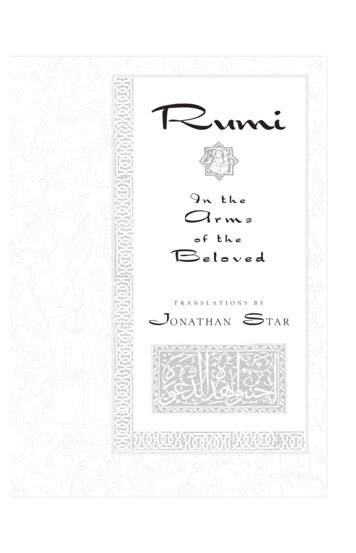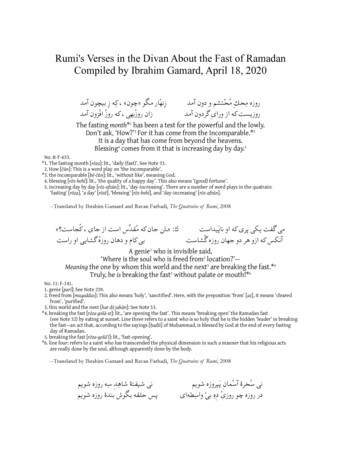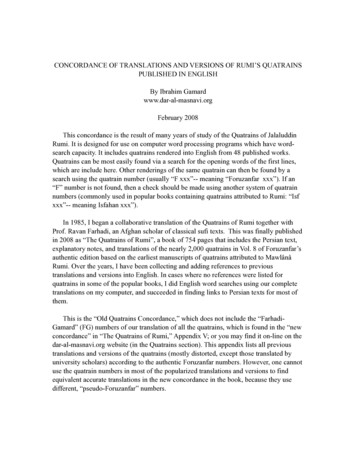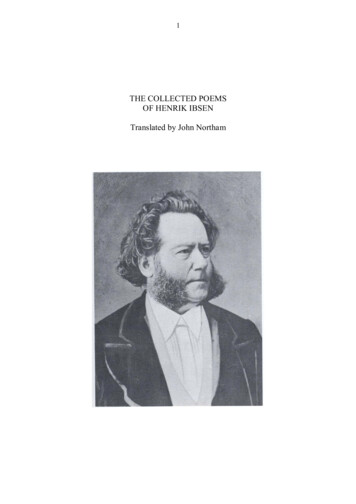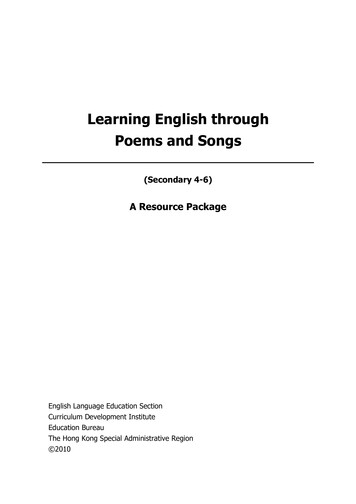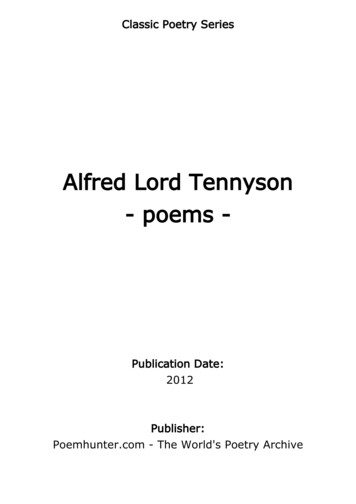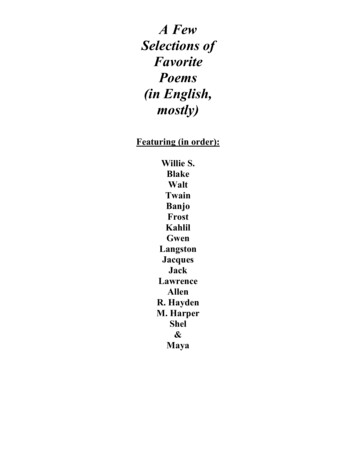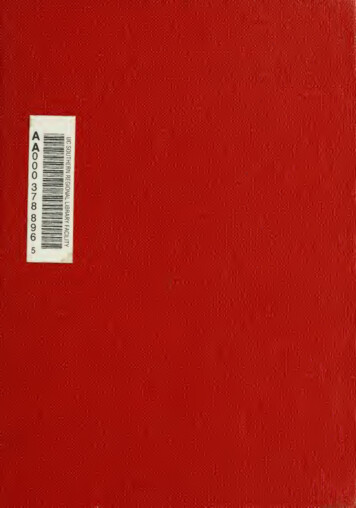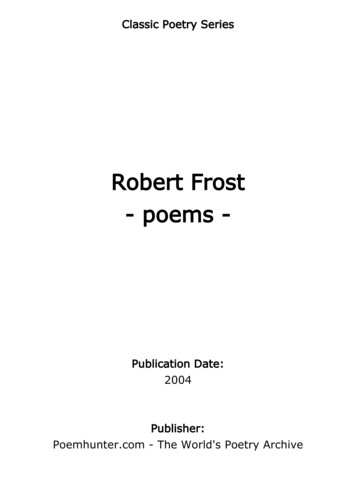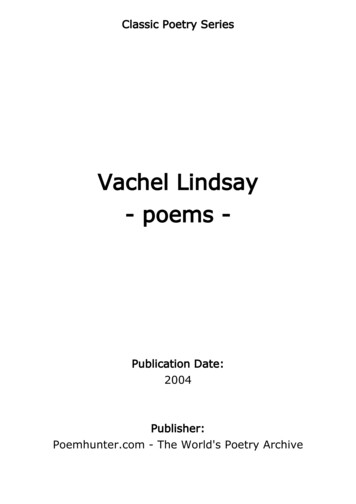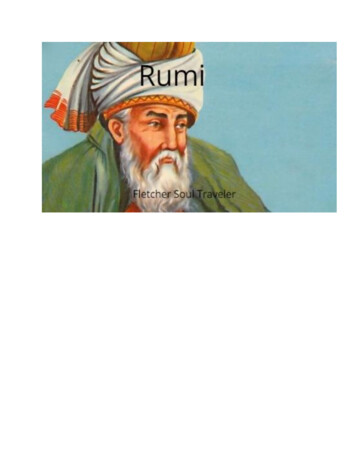
Transcription
mystical poemsof rumi
UntitledSadegh Tabrizi, 100 x 100 cm, ink on parchment
mystical poemsof rumiTranslated from the Persian byA. J. ArberryAnnotated and prepared byHasan JavadiForeword to the new and corrected edition byFranklin D. LewisGeneral Editor,Ehsan YarshaterThe University of Chicago Press Chicago ' London
The translations in this volume were originally published in two books. The firstvolume, including the first 200 poems, or ghazals, appeared in 1968 under the titleMystical Poems of Rūmı̄ 1, First Selection, Poems 1– 200. It was part of a UNESCOCollection of Representative Works and was accepted in the translation series of Persianworks jointly sponsored by the Royal Institute of Translation of Teheran and UnitedNations Educational, Scientific, and Cultural Organization (UNESCO). The secondselection, prepared by Hasan Javadi, was published in 1979 by Bibliotheca Persica asnumber 23 in their Persian Heritage Series, edited by Ehsan Yarshater with the assistanceof the Center for Iranian Studies at Columbia University. It was reprinted in 1991 by theUniversity of Chicago Press under the title The Mystical Poems of Rūmı̄ 2, SecondSelection, Poems 201–400. This combined and corrected edition contains the text and notesfrom those two books as well as significant revisions based on a new reading of Arberry’soriginal handscript and some new notes and a new foreword by Franklin D. Lewis.Published by arrangement with Bibliotheca Persica.The University of Chicago Press, Chicago 60637Poems 1–200 and notes to poems 1–200 1968 by A. J. ArberryPoems 201–400 and notes to poems 201–400 1979 by Ehsan YarshaterCombined and Corrected edition with a new Foreword by Franklin D. Lewis 2009by The University of ChicagoAll rights reserved.Originally published in two volumes. Poems 201–400 originally published in 1979 asNo. 23 in the Persian Heritage Series, Bibliotheca Persica.University of Chicago Press edition 2009Printed in the United States of America18 17 16 15 14 13 12 11 10 091 2 3 4 5isbn-13: 978-0-226-73162-9 (paper)isbn-10: 0-226-73162-6 (paper)Library of Congress Cataloging-in-Publication DataJalal al-Din Rumi, Maulana, 1207–1273.[Divan-i Shams-i Tabrizi. English. Selections]Mystical poems of Rumi / translated from the Persian by A.J. Arberry ; annotatedand prepared by Hasan Javadi; foreword to the new and corrected edition by FranklinD. Lewis ; general editor, Ehsan Yarshater.p. cm.Includes bibliographical references.isbn-13: 978-0-226-73162-9 (pbk. : alk. paper)isbn-10: 0-226-73162-6 (pbk. : alk. paper) 1. Jalal al-Din Rumi, Maulana,1207–1273—Translations into English. 2. Sufi poetry, Persian—Translations intoEnglish. I. Arberry, A. J. (Arthur John), 1905–1969. II. Javadi, Hasan. III. Lewis,Franklin, 1961– IV. Yar-Shater, Ehsan. V. Title.pk6480.e5a72 20082008034071891 .551—dc22 The paper used in this publication meets the minimum requirements of the American National Standard for Information Sciences—Permanence of Paper for Printed LibraryMaterials, ansi z39.48-1992.
contentsForeword to the New and Corrected Editionby Franklin D. Lewis (2008) 7Foreword to Volume 2, Mystical Poems of Rumiby Ehsan Yarshater (1978) 17An Autobiographical Sketchby A. J. Arberry 21Introduction to Volume 1, Mystical Poems of Rumiby A. J. Arberry 27t r an s l a tio n : po e m s 1–4 0 0Notes to Poems 377 37
A page from A. J. Arberry; translation of Mystical Poems of Rumi, in hisown handwriting, showing poems 285–287. (Courtesy of Hasan Javadi).
forewordt o t h e n e w a n d c o rre c te d e d i t i o nA professorship of Arabic at Cambridge University was established in 1632 and endowed by Thomas Adams, who had madehis fortune as a draper and haberdasher, and later went on tobecome the Lord Mayor of London. As its name implies, theSir Thomas Adams’s Professorship of Arabic was to be devotedto the study of Arabic—it is the oldest endowed professorshipfor this purpose in the English-speaking world. Several of theprofessors who occupied the Sir Thomas Adams chair at Cambridge in the twentieth century—E. G. Browne, C. A. Storey,R. A. Nicholson, and A. J. Arberry—were, however, equally oreven more renowned as Persianists. Indeed, the latter two especially distinguished themselves as scholars of the Persian mystical poet Maulānā Jalāl al-Dı̄n Rūmı̄, now known in Englishsimply as Rumi, or in Turkey as Mevlana.While Edward Granville Browne (1862–1926) was perhaps notas enamored of Rumi (Jalálu’d-Dı́n Rúmı́, as the scholarly conventions were then spelling his name) as two of his successors to[ 7 ]
the Sir Thomas Adams’s Professorship of Arabic would be, henevertheless passed on to his students a deep and abiding lovefor the poet he described as “without doubt the most eminentS.úfı́ poet whom Persia has produced, while his mystical Mathnawı́ deserves to rank amongst the great poems of all time.”1 In1898, Browne’s student Reynold Alleyne Nicholson (1868–1945)published a selection of forty-eight of Rumi’s Persian ghazalswith facing-page translation in English, accompanied by scholarly notes.2 Nicholson would later go on to edit and translateRumi’s great narrative poem the Masnavi (also transliteratedas Mathnavı̄ or Mathnawı́), a project to which he devoted alarge part of his scholarly career. Although attempts had beenmade to translate parts of Rumi’s Masnavi into English beforeNicholson did so, his selection from Rumi’s Dı̄vān-i Shams-iTabrı̄z, or “great Dı̄vān” (Dı̄vān-i kabı̄r), was the first workin English devoted to Rumi’s ghazals, of which Nicholson remarked, they “reach the utmost heights of which a poetry inspired by vision and rapture is capable.”Arthur J. Arberry (1905–69), the translator of the presentwork, had attended the funeral of Professor E. G. Browne in1926 and in 1927 received the scholarship for Cambridge students Browne had established in his will. Arberry used thisscholarship to pursue his studies in Persian and Arabic, becoming a student of R. A. Nicholson and obtaining his doctorateat Cambridge in 1936. In 1944, after some time spent in Cairo,A. J. Arberry succeeded Vladimir Minorsky as Chair of Persianat the School of Oriental and African Studies at the Universityof London. Meanwhile, back in Cambridge, C. A. Storey hadsucceeded Nicholson as Thomas Adams Professor of Arabic.1. E. G. Browne, A Literary History of Persia, vol. II: From Firdawsı́ toSa’dı́ (London: T. Fisher Unwin and New York: C. Scribner’s Sons, 1906;reissued: Cambridge: The University Press, 1928 and several reprints. ReissuedBethesda, Maryland: Iranbooks, 1997), 515.2. Selected Poems from the Dı̄vāni Shamsi Tabrı̄z, trans. R. A. Nicholson(Cambridge University Press, 1898, reissued in 1952, paperback edition 1977;reissued by Ibex publishers in 2002)franklin d. lewis[ 8 ]
But when Storey retired in 1947, Arberry returned to Cambridgeto himself assume the position of his former teacher, Nicholson,and his benefactor, Browne, as Sir Thomas Adams Professor.Though Arberry did not publish on Rumi while Nicholsonwas still alive, during his twenty-year career at Cambridge hedevoted much of his scholarly efforts to building upon his mentor’s project of translation and introduction of Rumi to theWest. Arberry’s voluminous scholarly output included translations of some poems of Rumi in his Immortal Rose: An Anthology of Persian Lyrics (London: Luzac, 1948), verse translations of Rumi’s quatrains (rubā‘ı̄yāt, 1949), his translation ofRumi’s lectures and discourses (Fı̄hi mā fı̄h, 1961), two volumesof prose translations of selected stories from Rumi’s Masnavı̄(1961 and 1963), selections from the spiritual diaries of Rumi’sfather, Bahā’ al-Dı̄n-i Valad (Ma‘ārif, 1964), and an extendedselection of Rumi’s mystical lyrics (1968 and, posthumously,1979). We may also note that during these years Arberry alsotranslated two works tangentially related to Rumi: both theQur’ān itself, which figures so prominently in Rumi’s poetry,as well as the famous modern Persian poem by MuhammadIqbal, in which Rumi features as a character, guiding Iqbal (justas Virgil guided Dante) through the heavens.3 Beyond all this,Arberry had announced in 1961 a hope to publish a “full studyof the life, writings and teachings of Rumi” which was toinclude an “extended analysis of the contents, pattern anddoctrine of the Masnavi,” which, sadly, he did not live longenough to complete.43. The Koran Interpreted, trans. A. J. Arberry (London: Allen and Unwin;New York: MacMillan, 1955), which has served as a standard source for quotations of the Qur’ān in English. And Muhammad Iqbal, Jāvı̄d-nāma, trans.A. J. Arberry (London: Allen and Unwin, 1966).4. The following chronological capsule summarizes Arberry’s great contribution to the study of Rumi:1949 The Rubâ ı̂yât of Jalâl al-Dı̂n Rûmı̂ (London: E. Walker)1961 Discourses of Rumi (London: J. Murray)1961 Tales from the Masnavi (London: Allen and Unwin)foreword, 2008[ 9 ]
Arberry and Nicholson together thus provided the majorportal to the poetry of Rumi for English-language readers. Inthe decades since their death, many poets and modern interpreters have introduced new contemporary English versionsthat have popularized Rumi’s poetry. Yet many who claim to“translate” Rumi in English do not know Persian at all; theirglimpse of Rumi, and the inspiration they receive from him, infact often relies upon the pages of Nicholson and Arberry, oron English translations of Turkish translations of the Persian ofRumi. Without the scholarly translations of Nicholson and Arberry, it would have been impossible for poets like Robert Blyand Coleman Barks to recognize Rumi’s potential appeal andreimagine him as a new-age American poet. Because Nicholsonand Arberry were interested primarily in conveying the ideasand expressions of Rumi, their translations may lack the popular and literary appeal of subsequent English retranslations (orre-versions), but they are both more precise and much moreinformative about the particulars of Rumi’s thought than thewidely known popular versions.51963 More Tales from the Masnavi (London: Allen and Unwin)1964 Aspects of Islamic Civilization: As Depicted in the Original Texts(London: Allen and Unwin) [includes selected translations from thespiritual diary of Rumi’s father]1968 Mystical Poems of Rūmı̄ 1 (Chicago: University of Chicago Press)1979 Mystical Poems of Rūmı̄ 2 (Chicago: University of Chicago Press)5. Other Persian scholars have since published direct translations of Rumi’sghazals from the Persian, including William Chittick in The Sufi Path of Love:The Spiritual Teachings of Rumi (Albany: The State University of New YorkPress, 1983); Talat Halman and Metin And in Mevlana Celaleddin Rumi andthe Whirling Dervishes (Istanbul: Dost Yayınları, 1983); Annemarie Schimmelin Look! This is Love (Boston: Shambala, 1991), and myself in Rumi: Past andPresent, East and West (Oxford: Oneworld, 2000) and Rumi: Swallowing theSun (Oxford: Oneworld, 2008). In German there is J. Christoph Bürgel, Lichtund Reigen: Gedichte aus dem Diwan der größten mystischen Dichters persischer Zunge (Bern: Herbert Lang and Frankfurt: Peter Lang, 1974) and a revised, expanded edition of that, published as Rumi: Gedichte aus dem Diwan(Munich: Beck, 2003); and in French, Leili Anvar Chenderoff in Rûmı̂(Paris: Entrelac, 2004).franklin d. lewis[ 10 ]
Indeed, Nicholson’s translations of selected poems of theDı̄vān-i Shams are still in print 110 years later, and Arberry’s twovolumes of Mystical Poems of Rumi, containing four hundredpoems from the Dı̄vān-i Shams, continue to inspire popular retranslations (including some by Colin Stuart, Coleman Barks,Kabir Helminski, and Raficq Abdulla, etc.). The two volumesof Arberry’s Mystical Poems of Rumi have even been reprintedseveral times in Iran, presumably so that Persian-speakers caneither share their favorite ghazals from Rumi with their nonPersophone friends and relatives, or use Arberry’s English as agloss, where the meaning of the Persian may be not quite transparent to modern Iranians!6It was the summer after my freshman year in college—a little over a year after the revolution in Iran—when I bought myown copy of volume one of A. J. Arberry’s Mystical Poems ofRumi. As the receipt has remained in my copy, I can be precise:it was purchased on July 18, 1980, at Cody’s Books (an influential institution, sadly now defunct) on 2454 Telegraph Avenuein Berkeley, California. It cost only 3.95, a grand total of 4.21after tax: a most rewarding purchase, one that I have frequentlyhad occasion to consult over the three intervening decades.This translation of 200 of Rumi’s ghazals had first beenpublished as Mystical Poems of Rūmı̄ in 1968, the year beforeArberry’s untimely death. It appeared as part of UNESCO’sCollection of Representative Works, jointly sponsored byUNESCO and the Royal Institute of Translation in Tehran, and6. These Iranian reprints of Arberry’s Mystical Poems of Rumi include onedone in Isfahan (Ibrāhı̄m Sipāhānı̄) in 2001; a parallel Persian and Englishtext, Guzı̄da-yi ghazalı̄yāt-i ‘irfānı̄-yi Maulānā: mushtamil bar 400 ghazalhamrāh bā tarjama-yi Ingilı̄sı̄ (Tehran: Nashr-i Būta, 2002); and Kalām-ikhāmūsh: guzı̄da-yi shi‘r va nasr-e Jalāl al-Dı̄n Muh.ammad bin Muh.ammadMaulavı̄-yi Rūmı̄ (Tehran: Hermes Publishers, 2004), a project of the International Centre for Dialogue among Civilisations in Tehran in the form of ahandy volume with the Persian text of Rumi facing Nicholson’s translationsof the Masnavı̄, and Arberry’s translations of Mystical Poems of Rumi, theRubâ‘ı̂yât, and the Discourses.foreword, 2008[ 11 ]
published by the University of Chicago Press.7 It was ProfessorEhsan Yarshater of Columbia University who had originallysuggested to Arberry in the early 1960s the important projectof translating Rumi’s ghazals. Arberry began to work on thisproject, probably in 1964, along with his assistant, Hasan Javadi,then a Lector at Ca
from those two books as well as significant revisions based on a new reading of Arberry’s original handscript and some new notes and a new foreword by Franklin D. Lewis. Published by arrangement with Bibliotheca Persica. The University of Chicago Press, Chicago 60637 Poems 1–200and notes to poems 1–200 1968by A. J. Arberry Poems 201–400and notes to poems 201–400 1979by Ehsan .
